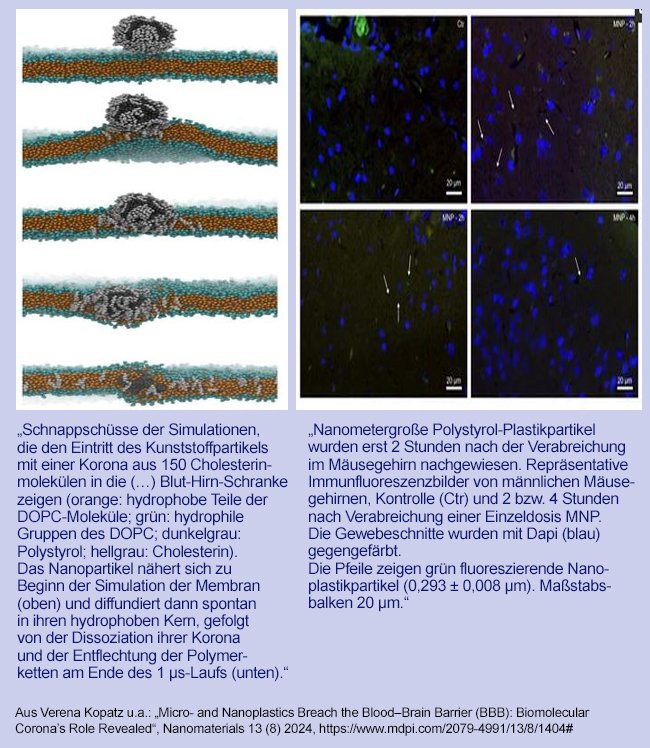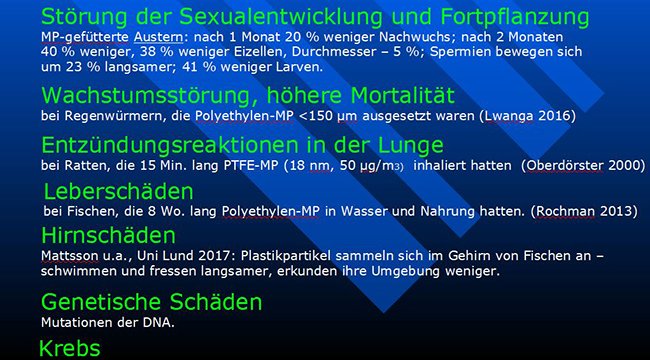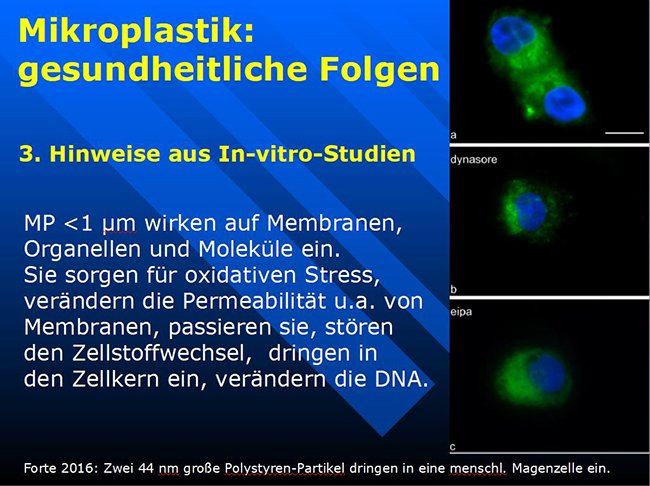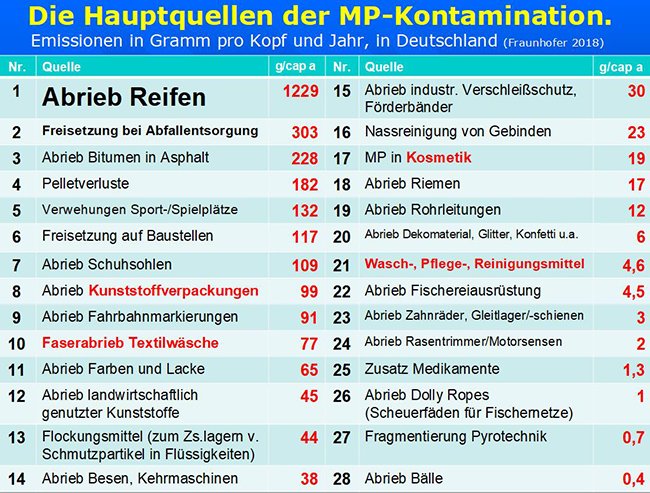by Dr.Harald Wiesendanger– Klartext
What the mainstream media is hiding
Five grams of microplastics enter our bodies every week. Within two hours of ingestion, the particles penetrate the brain. What are they doing there? A new study raises the worst fears.

No, they are no longer just in fish stomachs, raindrops, or the eternal ice of the Arctic. They are omnipresent and inescapable. We breathe them in, and we drink them, we eat them, and they penetrate our skin: our organism is increasingly becoming a dumpster for the indestructible decay products of the plastics industry. We inadvertently ingest five grams of microplastics every week – about the same as the weight of a credit card.
Most of these particles are in the nanometer range, between 1 and a maximum of 1000 nm. 1 nm corresponds to ten hydrogen atoms next to each other. A bacterium is a thousand times larger. In comparison, the tip of a needle has gigantic dimensions: it measures 1 million nanometers.
What do these tiny things do to us?
Microplastics can be detected in our urine and feces. (1) That’s why experts close to the industry rushed to give the all-clear: Apparently, we excrete the stuff undigested, similar to fiber, seed shells, and fruit kernels.
The fact that microplastics appear in our excrement does not mean they are not found elsewhere. And unfortunately, it does, as more and more studies show us with frightening clarity. In nano format, it travels everywhere within us.
In the brain, within two hours
Coordinated by doctors at the University of Vienna, an international team of researchers has just discovered plastic particles in the brains of mice – just two hours after the animals consumed drinking water containing plastic. It had previously been mixed with nanoparticles made from polystyrene, a type of plastic found in food packaging such as yogurt cups and Styrofoam containers. Using computer models, the scientists used fluorescence signals to track how the plastic particles, which they had previously marked with dyes, were distributed. It turned out that the nanoparticles reach the brains of the mice via a previously largely unknown biological “transport mechanism.” The tiny particles can be absorbed by cholesterol molecules that sit on the surface of the brain membrane. Stored in small lipid packages, they break through the blood-brain barrier – an organic barrier made of blood vessels and tissue that usually protects the brain from toxins and other harmful substances.

Once in the brain, “plastic particles could increase the risk of inflammation, neurological disorders or even neurodegenerative diseases such as Alzheimer’s or Parkinson’s,” fears pathologist Lukas Kenner, one of the researchers involved.
Is there any compelling reason to believe that this only applies to mouse brains, not human ones?
However, the Viennese findings are less original than the media portrays them. As early as February 2022, Korean researchers reported that plastic particles smaller than two micrometers penetrated the protective blood-brain barrier. After a few days, they had accumulated particularly in the microglial cells, which form the immune defense of the central nervous system. There, the plastic dwarfs triggered increased inflammation and cell damage, even leading to apoptosis: immune cells died. It has long been known that a disruption of the microglial cell system can promote and worsen neurological diseases, such as Alzheimer’s, Parkinson’s, or multiple sclerosis. This doesn’t bode well for microplastics.
To investigate more closely what plastic does to microglial cells, the researchers added microplastic particles to cell cultures with human microglial cells. The particles quickly accumulated in the cells – and began to change them. Initially, the cells grew more slowly, divided less, and produced inflammatory markers called cytokines. Cell death increased.
A Chinese study published in early 2022 also concluded that inhaled plastic is associated with “apparent neurotoxicity”: “Polystyrene nanoparticles with a size of 80 nm can reach and deposit in the brains of mice through inhalation of aerosols. Mice inhaling them show fewer AChE activities than those inhaling water droplets.” Her behavior then changed significantly. AChE stands for acetylcholinesterase, an enzyme that is extremely important for the function of the synapses of nerve cells by breaking down the neurotransmitter acetylcholine into its basic building blocks. It acts primarily in the central nervous system, muscles, and autonomic nervous system.
Anywhere in the body
It’s not just the brain that is contaminated with plastic – microplastics migrate throughout the entire body. All organs are affected.
Researchers at the University of Hull found microplastics in the lung tissue of 11 (out of 13) people who underwent surgery. “We would have expected that particles of this size would be filtered out or retained before they reach this deep into the lungs,” comments Dr. Laura Sadofsky, lead author of the research report. Some of the particles found were as small as 0.003 millimeters; the most common microplastic particle found was polypropylene, commonly used in plastic packaging, textiles, syringes, and kitchen utensils. 12 different types of microplastics were found in the tissue: eleven in the upper part of the lung, seven in the tissue of the middle part, and 21 in the lower, the deepest part. Already in the In 1998, scientists discovered plastic fibers in more than a hundred tissue samples from lung cancer patients in the USA; 97 percent of the cancer-affected samples contained the fibers, as did 83 percent of the tumor-free tissue.
Microplastics also float in our blood. A Dutch study found it in 77% of all people tested. The average concentration of plastic particles was 1.6 micrograms – thousandths of a milligram – per milliliter of blood. Up to three different types of plastic were found in some blood samples. One in two contained polyethylene terephthalate (PET), which is used to make water and soda bottles; a third contained polystyrene, commonly found in food packaging; a quarter contained polyethylene, which is used to make plastic bags.
Previous studies detected microscopic plastic particles in placental tissue. What is worrying is that infants have up to ten times more plastic in their feces than adults.
A Finnish research group exposed intestinal cells to polyethylene particles for 48 hours. They then increasingly produced reactive oxygen species (ROS): extremely reactive molecules that can cause oxidative damage to the cell, including its DNA. This was particularly noticeable in the mitochondria, the “power plants” of the cell, which produce a large part of the energy that our organism needs for life. Their dysfunction can lead to various chronic illnesses, from muscle weakness to vision problems to epilepsy.
Animal testing fuels the worst fears.
Animal studies have long confirmed how microplastics spread and accumulate in the body. In the bodies of experimental animals, researchers found the largest amounts in the gastrointestinal tract, but also in the blood, lymph, and even the liver. The dramatic consequences of MP exposure are only beginning to emerge. In one study, pregnant rats were exposed to 20 nm nanopolystyrene beads through their lungs. Twenty-four hours later, the particles were found in the mother’s lungs, heart, spleen, and placenta, as well as the liver, lungs, heart, kidney, and brain of the fetus.
What are the effects of exposure in the womb? The fetus and placenta have a lower weight, cardiovascular disorders increase, and neurological functions and reproduction are impaired in the offspring.
Microplastic exposure reduced testosterone production in fish, frogs, sea snails, birds, and alligators. It led to malformations of the reproductive organs, fewer eggs, slower and delayed sperm, and fewer offspring. Male laboratory animals were “feminized”: They developed “feminine” behaviors, whereupon conspecifics avoided them.



Where does this stuff come from?
In the world’s oceans, there are an average of 13,000 microplastic (MP) particles floating on the surface per square kilometer – there are now 170 trillion, which is probably still a gross understatement – and there are a hundred times less. By 2050, our oceans could contain more plastic than fish. In some seas, plastic levels exceeded plankton six times as early as 2006. When exposed to light, it breaks down into smaller and smaller fragments, the so-called “mermaid tears” or “nurdles,” which act like sponges for toxic chemicals. Filter feeders take them in, which in turn are eaten by larger marine organisms. They are deposited in their body tissue. When contaminated fish are consumed, the toxins move up the food chain until they end up in a final repository called humans.
Rivers and lakes are even more polluted than the seas. The Rhine transports around 200 million MP particles daily, ten tons per year – on the surface alone. Lake Constance has 61,000 MP per square kilometer, and Lake Geneva 220,000. There are no longer any unpolluted bodies of water. If they are tapped to irrigate agricultural land and produce drinking water, further floodgates open for our microplastic contamination.
63,000 to 430,000 tons of microplastics end up on European farmland every year. 53 tons of MP are in the top five centimeters of Swiss floodplains. Sewage sludge, which is also processed into fertilizer, contains up to 24,000 particles per kilo of dry matter. There are up to 440,000 MP particles in one ton of compost. The organic waste from private households, retail, and restaurants, which biogas plants and waste disposal companies process into compost, is contaminated with plastic residues, e.g., shredded garbage bags. The compost is sometimes “enriched” with plastic granules.
The feed of farm animals is correspondingly contaminated. (2) All 12 samples of feed pellets and shredded feed examined were found to contain plastic. It’s not the farmers’ fault; it’s the manufacturers’ fault. They process a large part of the former food products, including those from supermarkets that they have delivered, including the packaging. Sorting them out thoroughly is too time-consuming for them. Is it any wonder that 100% of all pigs and cows examined had microplastics in their blood? Four out of five meat and dairy products tested were found to be contaminated with MP.
The same applies to almost all foods. Anyone who eats a lot of fish ingests 11,000 MP fragments per year from this source alone. Up to 700 MP per kilo have been found in salt; Commercially available sugar contained 100-350 plastic fibers and 30-40 fragments per kilo. All 19 honey samples examined contained 40-660 MP per kilo.
Our drinking water is also contaminated with plastic. A larger sewage treatment plant that purifies more than 250,000 cubic meters of water daily releases around 65 million microplastic particles into natural waters daily. In Europe, four to five MP particles float in every liter of tap water. No waterworks, but rather their own high-quality filter system, enables private households to avert this health risk as much as possible. (See CLEAR TEXT: “If you want healthy water, you have to filter it.”)
Even every breath contains plastic. A large city like Paris produces three to ten tons of microplastics yearly, up to 355 synthetic fibers per square meter daily. For every cubic meter of “fresh” air, we suck in 30 floating MP particles per hour through our nose and mouth – over a million per year.
The air indoors is particularly polluted. During a 20-minute meal alone, several hundred end up on our plates. Every year, we swallow around 125,000 when eating this way – in addition to those already in the food we eat.
A list from the Fraunhofer Institute names the primary sources of the omnipresent, inescapable MP environmental pollution. The abrasion from car tires, road surfaces, and road markings leads by far, followed by unfiltered by-products of waste disposal, losses in plastic production, drifts from sports fields and playgrounds, release on construction sites, and abrasion from shoe soles.

How do microplastics poison us?
The devilish plastic dwarves of consumer society pose a triple threat to our health:
(1.) as troublemakers: Due to special biophysical properties in the micro and nano range – size, shape, surface quality, charge, etc. – they affect biological processes everywhere in the body.
(2.) as poison injections: They release toxic additives into us. Many plastics contain plasticizers. Their chemical structure is similar to natural hormones such as the female sex hormone estrogen, the male sex hormone androgen, and thyroid hormones. As “endocrine disruptors,” they affect development, reproduction, neurological functions, metabolism, satiety, and immune function. Bisphenol-A (BPA), for example, is known to disrupt embryo development and is linked to heart disease and cancer. Phthalates regulate gene expression and can cause heart disease and genital abnormalities – especially in young boys – that may be passed down through multiple generations. DEHP has been linked to reduced sperm counts and multiple organ damage.
(3.) as “taxis” for other pathogens of all kinds. The tiny plastics act as magnets in us – they attract pollutants: traces of fire retardants; DDT and other insecticides; drug residues; Heavy metals such as lead, cadmium, chromium, arsenic, zinc, mercury, nickel; Viruses and bacteria. Docked to the plastic particles, they can be introduced.
There may not be a safe exposure level for tiny plastic particles. Even if the legislature were to decide at some point to set “limit values” for microplastic pollution, they would only be a poor placebo so that consumers continue to feel safe and remain calm. (See CLEAR TEXT: “The limit value scam”) The same applies to previous and planned countermeasures: waste avoidance, mechanical removal, combating bacteria, and alternative product materials could, at best, reduce the future plastic glut. But they do not clean our living environment, which is already thoroughly contaminated with microplastics, our agricultural soil, our seas, and our air – to the secret glee of the health industry.
Too Late? Pandora’s box has long since been opened.

(Harald Wiesendanger)
Editors Note > ‘We’re All Plastic People Now’: A Groundbreaking Documentary.
Remarks
I discuss further aspects in KLARTEXT “Microplastics in us: a time bomb.”
(1) /pii/S0160412022001258?via%3Dihub#f0005; https://www.sueddeutsche.de/gesundheit/mikroplastik-mensch-1.4181146 An Austrian study found 20 particles of nine different types of plastic, 50 to 500 micrometers in size, per ten grams of intestinal contents in eight adult test subjects from several continents. See Süddeutsche Zeitung, October 24, 2018: “Plastic in the stomach”.
(2) https://interestingengineering.com/science/microplastics-in-meat-milk-and-blood-of-farm-animals, https://www.plasticsoupfoundation.org/en/2022/07/80-of -cow-and-pig-meat-blood-and-milk-contains-plastic/

Microplastics in the body: Do you know methods to eliminate them? We would like to ask you to send us any information: vorstand@stiftung-auswege.de. We would be happy to forward them to our readers.
